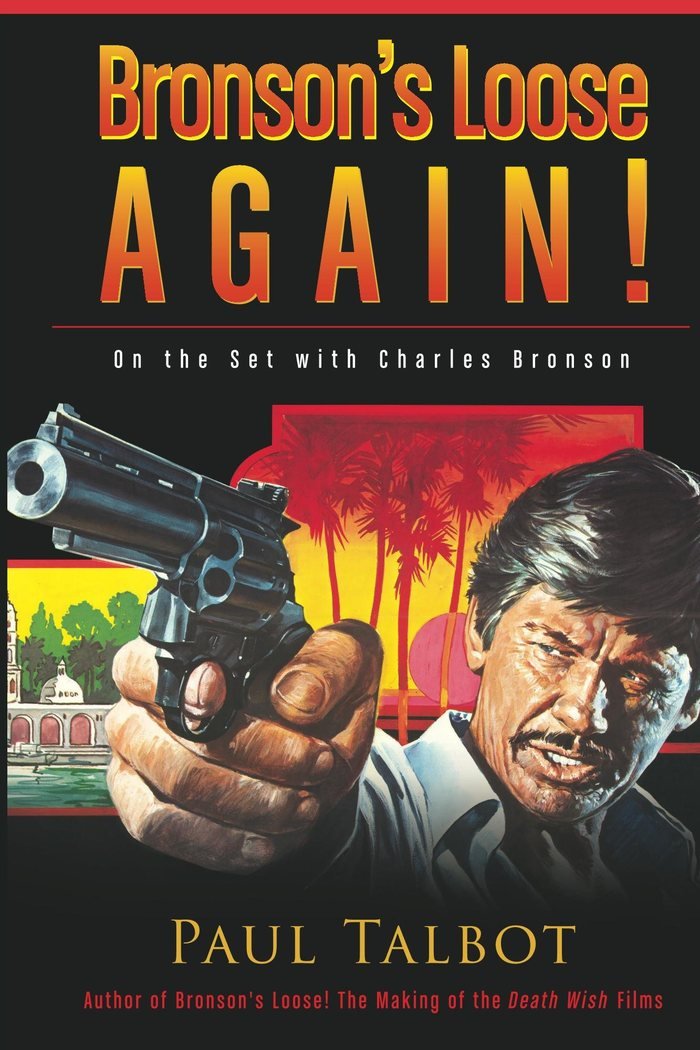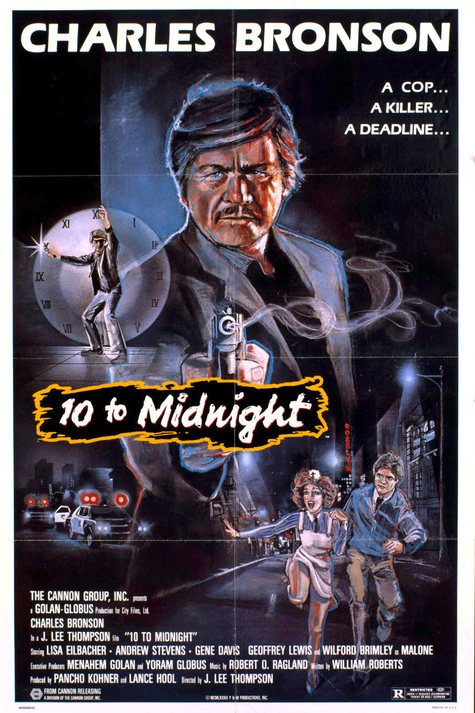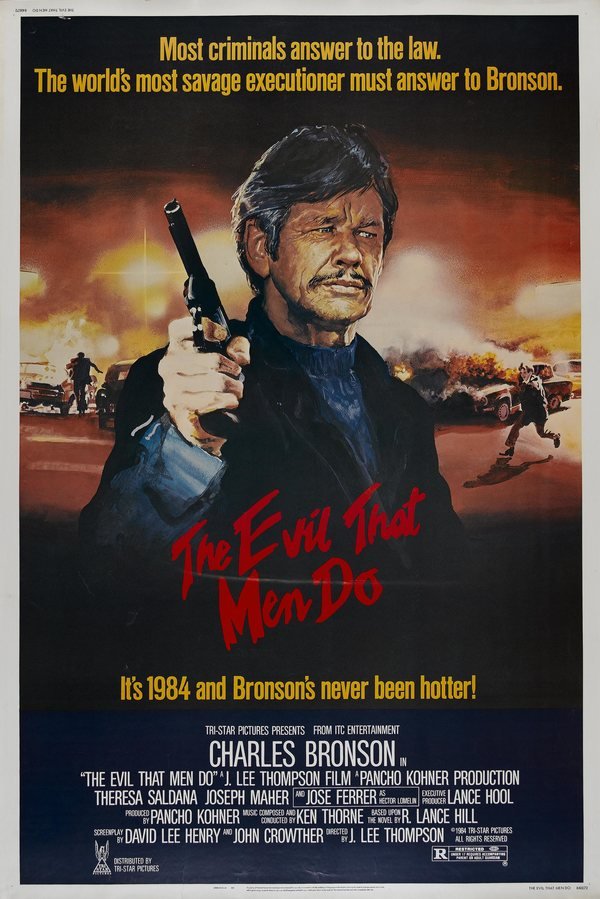BRONSON'S LOOSE AGAIN: Deeper Into Charlie's Career, All Cannons Blazing
A few years ago, Schlockmania reviewed Bronson's Loose, an excellent history of the Death Wish film series penned by Paul Talbot. It quickly became a favorite with the cult/exploitation movie crowd and Talbot continued to build his reputation in these circles with a variety of magazine pieces and Mondo Mandingo, his amazing tome on the infamous Mandingo novel series and the films its inspired. Talbot has come full circle with Bronson's Loose Again, which travels deeper into the Bronson filmography to create a fascinating travelogue through the final two decades of this still-underrated star's career. Bronson's Loose Again is not a biography nor is it a study of Bronson's film career in full. Instead, Talbot concentrates on Bronson's post-Death Wish period, bypassing the Death Wish sequels he covered in the prior book and any other titles that have been extensively covered in other related biographical tomes (hence, no chapters on films like Mr. Majestyk or Telefon).What he covers is likely to delight the action hero's fans as it provides extensive information on his tenure with Cannon Films, the period that made him an exploitation film icon, as well as plenty of info on the expensive productions he made for ITC Entertainment and the oft-overlooked t.v. films he made in his final years. Death Wish fans will be happy to know he also includes some bonus interviews with people who worked on that series of films that bring out new angles on those enduring favorites.The result is a treasure of cult movie scholarship. Talbot mixes a blend of skillfully researched info from prior books, newspapers and magazine articles with 39 new interviews conducted by the author himself for this book. As a result, you get a nice blend of vintage info you'd expect from a book like this with a lot of brand-new details as well as personalized perspectives that add fresh context to the familiar facts. Each chapter offers a complete portrait of a film from conception to finished product, along with details on unmade projects that popped up between the films Bronson made and snippets of the oft-withering reviews that the films received.
Bronson's Loose Again is not a biography nor is it a study of Bronson's film career in full. Instead, Talbot concentrates on Bronson's post-Death Wish period, bypassing the Death Wish sequels he covered in the prior book and any other titles that have been extensively covered in other related biographical tomes (hence, no chapters on films like Mr. Majestyk or Telefon).What he covers is likely to delight the action hero's fans as it provides extensive information on his tenure with Cannon Films, the period that made him an exploitation film icon, as well as plenty of info on the expensive productions he made for ITC Entertainment and the oft-overlooked t.v. films he made in his final years. Death Wish fans will be happy to know he also includes some bonus interviews with people who worked on that series of films that bring out new angles on those enduring favorites.The result is a treasure of cult movie scholarship. Talbot mixes a blend of skillfully researched info from prior books, newspapers and magazine articles with 39 new interviews conducted by the author himself for this book. As a result, you get a nice blend of vintage info you'd expect from a book like this with a lot of brand-new details as well as personalized perspectives that add fresh context to the familiar facts. Each chapter offers a complete portrait of a film from conception to finished product, along with details on unmade projects that popped up between the films Bronson made and snippets of the oft-withering reviews that the films received. The chapters on the Cannon years alone make Bronson's Loose Again worthwhile for anyone into '80s action and exploitation. For example, there's an amazing chapter on 10 To Midnight in which Lance Hool reveals how the project was put together, Gene Davis gives insight into the inspirations for his performance as the psycho-killer villain and the reader gets to check out unshot scenes from the film in script form. Elsewhere, you'll learn about the origin of the colorful, nonsensical insults used by Kathleen Wilhoite's character in Murphy's Law and actor Robert Lyons, who appeared in three of Bronson's Cannon-era films, revealing what early Bronson hit he almost played the co-lead in.Talbot also does a fine job of shining light on the lesser-known films that Bronson did during this time. For example, there's an excellent chapter on From Noon Till Three, a blend of satire, romance and western that was one of Bronson's favorite projects. This chapter benefits from a thorough interview with the film's writer/director, Frank D. Gilroy. It also reminds the reader how Bronson aspired to be more than just an action hero as well as how studios and critics alike did their best to keep shoving him back into that category. Along similar lines, a chapter on the illegal immigration drama Borderline makes a nice case for one of Bronson's most overlooked films. Of equal interest are a few chapters that reveal how a deal with English film mogul Sir Lew Grade led to costly but muddled items like Love And Bullets and Cabo Blanco.
The chapters on the Cannon years alone make Bronson's Loose Again worthwhile for anyone into '80s action and exploitation. For example, there's an amazing chapter on 10 To Midnight in which Lance Hool reveals how the project was put together, Gene Davis gives insight into the inspirations for his performance as the psycho-killer villain and the reader gets to check out unshot scenes from the film in script form. Elsewhere, you'll learn about the origin of the colorful, nonsensical insults used by Kathleen Wilhoite's character in Murphy's Law and actor Robert Lyons, who appeared in three of Bronson's Cannon-era films, revealing what early Bronson hit he almost played the co-lead in.Talbot also does a fine job of shining light on the lesser-known films that Bronson did during this time. For example, there's an excellent chapter on From Noon Till Three, a blend of satire, romance and western that was one of Bronson's favorite projects. This chapter benefits from a thorough interview with the film's writer/director, Frank D. Gilroy. It also reminds the reader how Bronson aspired to be more than just an action hero as well as how studios and critics alike did their best to keep shoving him back into that category. Along similar lines, a chapter on the illegal immigration drama Borderline makes a nice case for one of Bronson's most overlooked films. Of equal interest are a few chapters that reveal how a deal with English film mogul Sir Lew Grade led to costly but muddled items like Love And Bullets and Cabo Blanco. Death Wish fanatics will appreciate the new interview related to those films, which yield new information on a subject that fans might have though they already know inside-out. For instance, David Engelbach reveals how he reluctantly became the screenwriter for Death Wish II and actress Silvana Gallardo speaks frankly about how shooting the infamous rape scene in Death Wish II was not only tough for her but for everyone else involved (tellingly, the first cinematographer and his crew quit in protest over director Michael Winner's vicious approach to this scene). Also, Death Wish III fans will appreciate getting a chance to hear from that film's "Giggler," Kirk Johnson, reveal the serious work involved in creating this kitschy highlight of the Death Wish sequels.Along the way, Bronson's Loose Again gives the reader an up-close portrait of the enigmatic star. Though it is not designed as a biography, the mixture of old and new interviews create a complex portrait of a talented, intelligent actor who could be difficult or aloof but had an equal capacity for loyalty and kindness with those he took into his trust. You also get a nice feel for his relationship with wife and frequent co-star Jill Ireland, who often smoothed out his rough edges and was an equal partner in his career. Talbot gently layers these biographical threads throughout the book and it adds a subtle but noticeable depth to its coverage of Bronson's career.Someone could produce a review with the twice the word count on this book - this review hasn't even touched on the excellent, extensive chapters on Schlockmania favorites like Hard Times, The Evil That Men Do and Kinjite: Forbidden Subjects - but for the sake of brevity, this review will leave those highlights for the review to discover on their own. The only thing left to say is that Bronson's Loose Again is a necessity for anyone with an interest in Charles Bronson's career - and it'll leave you hoping that Talbot will revisit the star's work once more for a book that could cover the films omitted here.
Death Wish fanatics will appreciate the new interview related to those films, which yield new information on a subject that fans might have though they already know inside-out. For instance, David Engelbach reveals how he reluctantly became the screenwriter for Death Wish II and actress Silvana Gallardo speaks frankly about how shooting the infamous rape scene in Death Wish II was not only tough for her but for everyone else involved (tellingly, the first cinematographer and his crew quit in protest over director Michael Winner's vicious approach to this scene). Also, Death Wish III fans will appreciate getting a chance to hear from that film's "Giggler," Kirk Johnson, reveal the serious work involved in creating this kitschy highlight of the Death Wish sequels.Along the way, Bronson's Loose Again gives the reader an up-close portrait of the enigmatic star. Though it is not designed as a biography, the mixture of old and new interviews create a complex portrait of a talented, intelligent actor who could be difficult or aloof but had an equal capacity for loyalty and kindness with those he took into his trust. You also get a nice feel for his relationship with wife and frequent co-star Jill Ireland, who often smoothed out his rough edges and was an equal partner in his career. Talbot gently layers these biographical threads throughout the book and it adds a subtle but noticeable depth to its coverage of Bronson's career.Someone could produce a review with the twice the word count on this book - this review hasn't even touched on the excellent, extensive chapters on Schlockmania favorites like Hard Times, The Evil That Men Do and Kinjite: Forbidden Subjects - but for the sake of brevity, this review will leave those highlights for the review to discover on their own. The only thing left to say is that Bronson's Loose Again is a necessity for anyone with an interest in Charles Bronson's career - and it'll leave you hoping that Talbot will revisit the star's work once more for a book that could cover the films omitted here.


